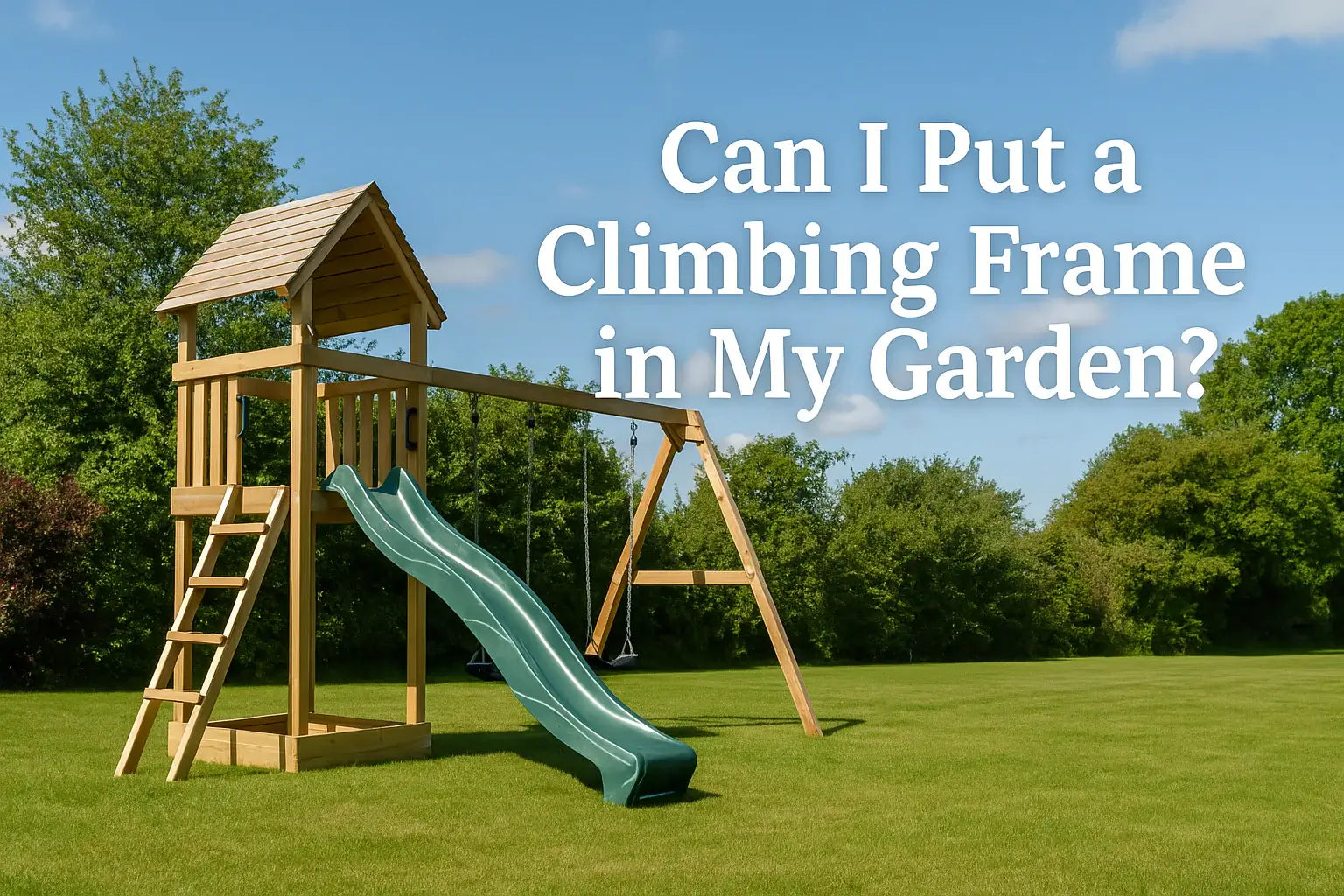
Can I Put A Climbing Frame In My Garden?
As parents, we’re always on the hunt for new ways to get the kids off screens and into the fresh air. A garden climbing frame often tops the list—but can you actually have one in your garden without stirring up trouble?
Short answer: yes, you can install a garden climbing frame—as long as you’ve got enough space, play it safe, and keep things neighbour-friendly.

When is Planning Permission Required?
Most of the time, you won’t need planning permission for a climbing frame. But like anything with rules, there are a few caveats. Size, height, and where you place it all matter.
Height, Boundary, and Coverage Rules
If the climbing frame is taller than 2.5 metres and sits within two metres of a boundary, that’s where things get tricky. You might need to apply for planning permission.
Plus, if the frame takes up a significant chunk of your garden, the council could raise an eyebrow. Best to keep things proportionate.
Raised Platforms and Balconies
Platforms over 30cm high can become privacy concerns—especially if they peek into a neighbour’s garden. Treehouse-style lookout towers might look fun but could require extra approval.
Special Considerations for Your Property
Not all gardens are treated equally. Some come with extra rules baked in.
Designated Land and Listed Buildings
Live in a listed property or within a conservation area? Your freedom to build could be limited. It’s worth giving your local council a ring before you start assembling anything.
Consequences of Not Getting Planning Permission
Tempted to skip the paperwork? That shortcut could lead to a long headache.
Enforcement Notices and Local Authority Checks
If your climbing frame breaks the rules, you might receive an enforcement notice—meaning it’ll need to come down. A quick check now can save you a costly mistake later.
Choosing the Right Location and Ensuring Safety for Your Climbing Frame
Assessing Your Garden's Suitability
Before setting up anything, walk your garden like a detective. What’s the ground like? Is there enough room to run around it safely?
Level Ground, Sun/Shade, and Space
Flat, even ground is a must. Watch out for overhead branches, sharp slopes or anything that could cause a wobble.
Think about sun exposure too. No one wants to fry on a metal slide or play in a shady spot that’s always damp.
Selecting the Best Safety Surfacing
Falls happen. The goal is to make sure they're no big deal.
Material Options and Fall Height
Rubber mulch, wood chips, or synthetic turf are all solid options. The higher the climbing frame, the softer the landing should be.
Grass can work for smaller frames, but it wears quickly. A bit of padding goes a long way.

Essential Safety Features and Installation
Building a climbing frame isn’t just about following the manual—it’s about thinking like a parent.
Anchoring, Guardrails, and Manufacturer Guidelines
Secure anchoring stops the frame tipping when the kids go wild. Guardrails are essential for higher platforms, especially with younger climbers.
Follow the manufacturer’s instructions to the letter. They’ve tested what works (and what doesn't).
Maintaining Your Climbing Frame and Addressing Neighborly Concerns
Regular Maintenance for Longevity and Safety
Just like a car or bike, your climbing frame needs TLC.
Inspections, Tightening, and Weather Protection
Give it a once-over every season. Look out for rust, cracks, loose bolts or wobbly bits.
In spring, clean off winter grime and touch up paint or protective coatings. In summer, double-check all bolts after a busy half-term. In autumn, clear leaves and debris. Come winter, make sure it can handle snow and damp.

Privacy and Overlooking: Keeping Your Neighbours Happy
A raised climbing frame can accidentally turn into a garden lookout tower. No one likes being watched while sipping tea in their dressing gown.
Overlooking Rules, Communication, and Screening
Have a quick chat with your neighbours before building. Most will appreciate the heads-up.
If needed, add a trellis, tall plants or reposition the frame. That way, kids have fun and privacy stays intact.
Resolving Potential Disputes with Neighbours
If a climbing frame becomes a sore spot, stay calm and keep talking.
Boundary Checks and Dispute Resolution Options
Double-check your garden boundaries before installing. If issues pop up, try mediation or get advice from your local authority.
Sometimes, a simple compromise—or a well-placed hedge—can make all the difference.
Conclusion
Installing a garden climbing frame can transform your outdoor space into a haven of adventure. Just make sure you’ve thought about safety, space, planning rules, and the view from next door.
Get it right, and your little ones will have endless fun—and your garden will still feel like your own sanctuary. Everyone wins.
Have you checked out our other posts?
How High Can A Climbing Frame Be?
Can I Put A Climbing Frame On Artificial Grass?
Do Climbing Frames Need Planning Permission?
Can You Put A Climbing Frame On A Slope?
Can You Put A Climbing Frame On Concrete?
What Is Best To Put Under A Climbing Frame?



Leave a comment